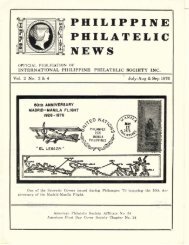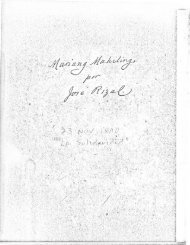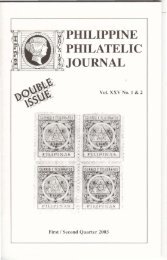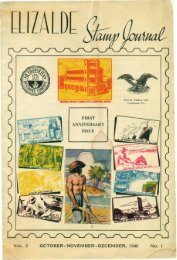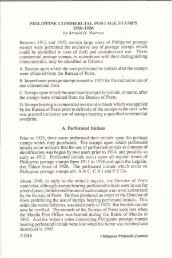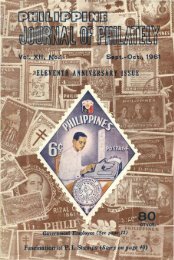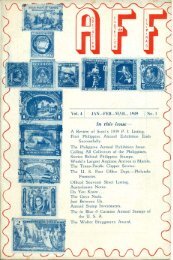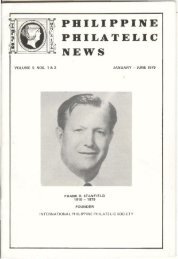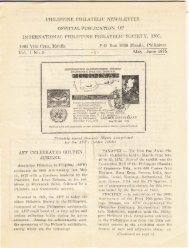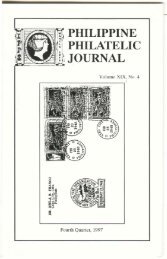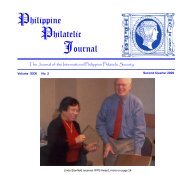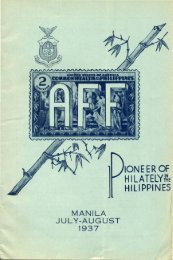April-December 1977, Vol. 3, No.s 2-4 - International Philippine ...
April-December 1977, Vol. 3, No.s 2-4 - International Philippine ...
April-December 1977, Vol. 3, No.s 2-4 - International Philippine ...
You also want an ePaper? Increase the reach of your titles
YUMPU automatically turns print PDFs into web optimized ePapers that Google loves.
ADDENDA: CENSOR MARKS OF THE JAPANESE<br />
OCCUPATION OF THE PffiLIPPINES. 1942-1943 •<br />
By Eugene A. Garrett<br />
Under the sponsorstup of the I.P.P.s., the first published study of the civilian mail censor marks of the Japanete<br />
Occupation of the <strong>Philippine</strong>s has appeared in two inJtaIlments in the August and September, <strong>1977</strong>. issues<br />
of THE AMERICAN PHILATELIST. Subsequent to the completion of the original manuscript in <strong>No</strong>vember,<br />
1976. certain Dew infannatioD has come to light, thanks to the splendid cooperation of several members of<br />
the I.P.P.S. Three YOI}' rare Type m censor marks were not illustrated in THE AMERICAN PHILATELIST<br />
article for the reason that they were known only from the data complied by Pablo M. £speridion for his<br />
unpublished study. "<strong>Philippine</strong> Censor Marks, World Was; II''. and had not been seen by this author. <strong>No</strong>w,<br />
however, photocopies of covers bearing strikes of those rare marks from the collection of Rudy Tan have<br />
been sent to the author, with the kind assistance of Linda Stanfield, Editor of this journal. A previously<br />
unknown censor mark has been reported by Fumiaki Wada., and information has been received from R.<br />
Hunter Ashmore. Jr.• and from Mr. Tan which also revises the "Dates of use and "Earliest reported use" for<br />
several of the marks.<br />
The new.ly~vered information is recorded below, as addenda to the original study. A very few errors in<br />
the published study are also recorded below. The numbering system for the new mark and for the illustrations<br />
fonow the numbering system employed in THE AMERICAN PHll.ATELIST article.<br />
RUBBER STAMPS<br />
Type IA - Bilingual, Japan... and English<br />
I. Manila, Type I<br />
I a.<br />
Dates of use: March 4.1942. to September 25.1942.<br />
Manila, Type Ia<br />
Dates of use: July 13. 1942, to Septem~r 15. 1942.<br />
The period of use of this "error" mark, with reversed order of kanji characters in the second row.<br />
was much longer than originally realized. It seems quite remarkable that the "error" was used for<br />
two months, apparently undetected by the Japanese "advisers" in the Bureau.<br />
2. Manila, Type 2 .<br />
Dates of use: September 26, 1942. to June 30.1943.<br />
It now seems apparent that the use of the Manila. Type I, mark was discontinued on Friday.<br />
September 25. replaced by the more grammatical Type 2 mark on the fonowing day, Saturday,<br />
3.<br />
September 26, 1942.<br />
Legaspi, A1bay<br />
Earliest reported use: <strong>December</strong> 8. 1942<br />
8. Tacloban, Leyte<br />
E ,nest reported use: <strong>April</strong> 8, 1943<br />
«( ;'ection: the katakana inscription b '"Tuuroban", not ·"Takoroban".)<br />
It is now recognized that standard practice in Tacloban was to impress this mark partly over the<br />
flap and partly over the rest of an envelope after it had been sealed by the censor.<br />
9. Baguio, Mountain<br />
Earliest reported use: <strong>December</strong> 8. 1942<br />
Type m- Japanese language, vertical rectangular shape, provincial town name in katakana syllabics.<br />
2. Doilo-Doilo<br />
9.<br />
Fit. ~iest reported use: <strong>December</strong> 3.1942<br />
~.~,A1baY<br />
Figure 23.<br />
36




